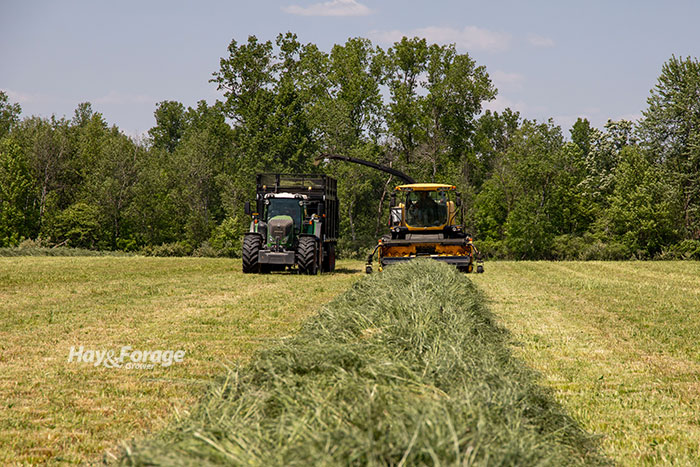Give perennial grasses some credit |
| By Amber Friedrichsen, Associate Editor |
|
|
 In many cases, alfalfa tends to take the cake when it comes to a farmer’s favorite forage. Among its heralded characteristics are a high crude protein content, perennial ground cover to reduce erosion, and the ability to fix nitrogen in the soil. Despite these favorable features, though, alfalfa doesn’t always live up to its renowned reputation. Greater instances of winterkill and a plateau in annual yield are just two issues that have humbled alfalfa’s high status and led producers to consider growing other forages to fill production gaps. In a recent The Dairy Signal webinar from Professional Dairy Producers of Wisconsin (PDPW), Jason Cavadini, extension grazing specialist with the University of Wisconsin–Madison, and Matthew Oehmichen, co-owner of Short Lane AG Supply, discussed the benefits of incorporating cool-season grasses into perennial forage systems. More specifically, they suggested grass species can be added to or replace alfalfa stands to boost forage quality for dairy cattle. Cavadini started by stating grass forage production has historically been an afterthought to alfalfa production. In other words, grasses have been considered inferior to alfalfa because they generally have lower crude protein and are not managed as intensively. “If you look at where farmers have grasses on farms, they are in fringe areas, or not the most productive acres. They are often not fertilized as they should be and only cut two or three times per year,” Cavadini said. “We are really leaving a lot of potential out there,” he added. To explore this potential, Cavadini and other researchers with the University of Wisconsin–Madison created a study to maximize cool-season grass production of different species that are commonly recommended to farmers in the Badger State. These included varieties of tall fescue, orchardgrass, perennial ryegrass, meadow fescue, and festulolium. Researchers cut forage four to five times per year and fertilized stands between cuttings. In 2020, grass yields ranged from 4.8 to 6.6 tons of dry matter per acre across four cuttings, whereas yields were between 5.2 and 6.9 tons of dry matter per acre across five cuttings in 2021. This data was not used to compare the grasses in the experiment to each other, but rather to estimate expected yields for the different species and varieties. Alfalfa was also planted in the trials for reference, and yields were 6.2 and 6.1 tons per dry matter per acre in 2020 and 2021, respectively. Cavadini said cool-season grass yields are fairly consistent from year-to-year, but he predicted this year’s drought conditions may set these numbers back a bit. Even so, he predicts this discrepancy in grass yields will not be as drastic as that of alfalfa or annual forage species. What does vary from one year to the next, however, is when grasses mature, which plays a larger role in forage management and harvest timing. Grass versus alfalfa quality Grasses tend to be lower in quality for first cutting, but feeding value typically improves with subsequent harvests. Cavadini explained this is because plants rapidly progress toward reproductive stages at the beginning of the growing season until seedheads have been removed. “One of the things that makes grasses nice for management is that we only have to worry about this stage where they are racing toward maturity and trying to put out a seedhead to become reproductive one time,” Cavadini said. “If we take care of that seedhead one time, we are setting the plant back to a vegetative stage — which is the best quality — for the duration of the season.” Additionally, Cavadini mentioned forage quality in grasses declines slower than that of alfalfa. To demonstrate this, he presented data from the first and second cuttings in 2021 when field plots were harvested when alfalfa stands were in the 25% flowering stage. The relative forage quality (RFQ) of alfalfa was 140 at first cutting, while the RFQ of the grass species in the study was between 148 and 168. Likewise, the RFQ of alfalfa at second cutting was 158 and the grasses had RFQs of 162 to 181. “We understand that no high-producing dairy farm is going to cut alfalfa at this stage, but you can see where the grasses ended up,” Cavadini said. “The point we are trying to drive home here is that grasses buy you some time.” Select a suitable species Even though the yield and quality of cool-season grasses can prevail over alfalfa with proper management, Cavadini and Oehmichen suggested the most important factor of introducing grasses into a forage system is species selection. They advocated for choosing a grass species and variety that is well-suited for the soil and moisture conditions of a specific site. “All of these grasses have a different niche, or a different environment that they thrive in,” Cavadini said of the species in the study. “It’s really important that we understand what those are so that we can pick a species correctly.” To demonstrate this, Cavadini said meadow fescue tends to have higher neutral detergent fiber digestibility (NDFD) than other grasses like tall fescue and orchardgrass. Greater NDFD drives greater feed intake, which is necessary to meet the energy demands of dairy cattle. With that said, meadow fescue requires particular soil conditions to achieve its high feeding value potential. “Meadow fescue wants a little more specific environment. It can’t tolerate overly dry or excessively wet. It needs to be somewhere in the middle,” Cavadini explained. “Farmers will often go with tall fescue or orchardgrass because they are more conducive to a wider range of conditions.” To conclude, Cavadini encouraged farmers to take forage samples and assess test results to enhance livestock feeding programs. He also recommended buying high-quality seed from a trusted source and avoiding variety not stated (VNS) products. |
